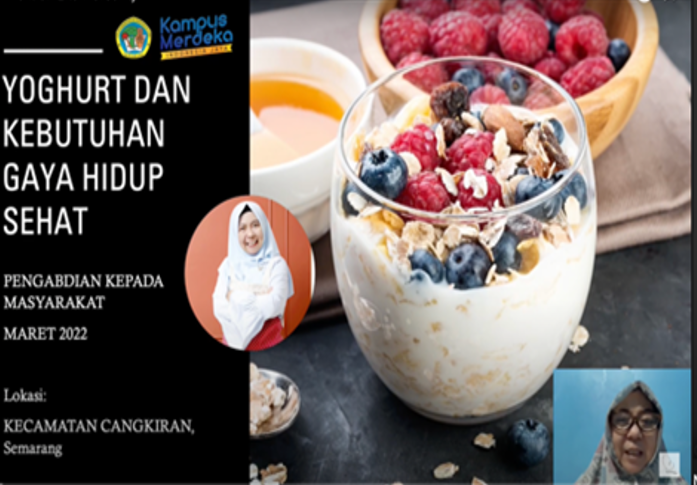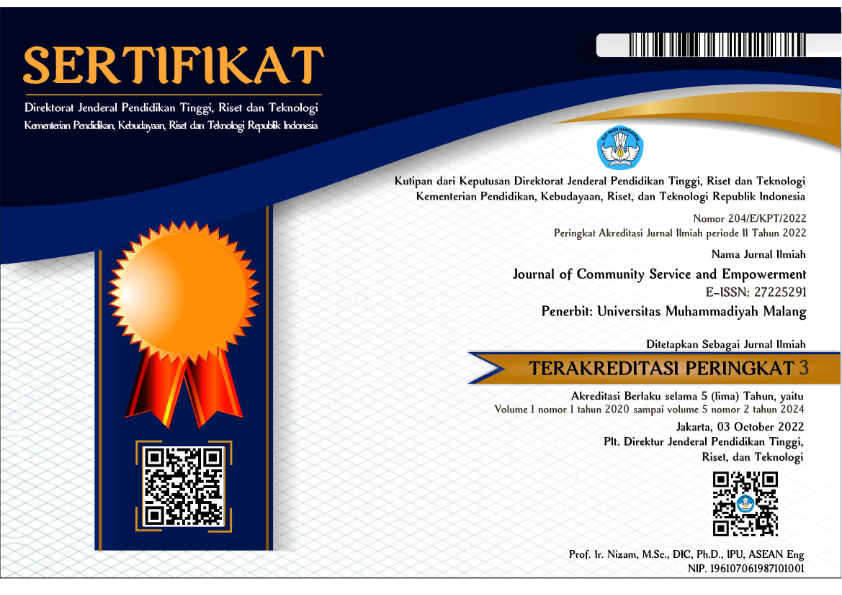Yoghurt making training to build women’s resilience in developing local economy and healthy lifestyle
DOI:
https://doi.org/10.22219/jcse.v3i2.21034Keywords:
Cangkiran, City branding, Healthy lifestyle, Thematic village, YoghurtAbstract
Lifestyle modifications are becoming increasingly important, especially following the epidemic era. Healthy living is a continual lifestyle that aids the attempt to transform a healthy culture and the production of healthy cells. A healthy lifestyle is one that consider all facets of a person's health. Not only about food but also about exercise and lifestyle practices. Health is vital to all our actions. One of the important things in supporting health can be done with healthy food intake. Making homemade yogurt, changing other foods, and changing one's lifestyle are all part of this activity. Thus, this activity aims to train partners in yogurt making to build women's resilience in developing local economies and healthy lifestyles. Activities are hybrid, with some participants and resource personnel working online and others offline at the activity site. The method of activities is carried out using lectures, discussions and hands-on practice which is carried out in a hybrid between online and offline. Some participants and resource persons carry out activities online and partly offline at the activity location. This activity is women's independence to build a home industry producing yogurt and other nutritious foods has increased, as has the production of processed yogurt. It is anticipated that the independence of these women will encourage the self-assurance necessary to construct a healthy family and environment, making their residence a place of business and a healthy gastronomic destination at home.
Downloads
References
Abe, T., Nofuji, Y., Seino, S., Murayama, H., Yoshida, Y., Tanigaki, T., … Kitamura, A. (2020). Healthy lifestyle behaviors and transitions in frailty status among independent community-dwelling older adults: The Yabu cohort study. Maturitas, 136, 54–59.
Anttiroiko, A.-V. (2014). The political economy of city branding. Routledge.
Behrens, G., Fischer, B., Kohler, S., Park, Y., Hollenbeck, A. R., & Leitzmann, M. F. (2013). Healthy lifestyle behaviors and decreased risk of mortality in a large prospective study of U.S. women and men. European Journal of Epidemiology, 28(5), 361–372. https://doi.org/10.1007/s10654-013-9796-9
Braun, E. (2012). Putting city branding into practice. Journal of Brand Management, 19(4), 257–267.
Çelebi, E., Gündogdu, C., & Kizilkaya, A. (2017). Determination of Healthy lifestyle behaviors of high school students. Universal Journal of Educational Research, 5(8), 1279–1287.
Chakravorty, S. (2005). Urban development in the global periphery: The consequences of economic and ideological globalization. In Globalization and urban development (pp. 29–39). Springer.
Ford, E. S., Bergmann, M. M., Boeing, H., Li, C., & Capewell, S. (2012). Healthy lifestyle behaviors and all-cause mortality among adults in the United States. Preventive Medicine, 55(1), 23–27.
Grossman, G. M., & Krueger, A. B. (1995). Economic growth and the environment. The Quarterly Journal of Economics, 110(2), 353–377.
Hák, T., Janoušková, S., & Moldan, B. (2016). Sustainable Development Goals: A need for relevant indicators. Ecological Indicators, 60, 565–573.
Jackson, J. K. (2021). Global economic effects of COVID-19. Congressional Research Service.
Kamil, S. U. R. (2017). City branding sebagai strategi komunikasi pariwisata kabupaten buton tengah. Metacommunication: Journal of Communication Studies, 2(1).
Karachyna, N., Vakar, T., Moroz, Y., Semtsov, V., & Vitiuk, A. (2020). Territorial Branding as an instrument for competitiveness of rural development. In Applications of Management Science. Emerald Publishing Limited.
Kelly, S. A., Melnyk, B. M., Jacobson, D. L., & O’Haver, J. A. (2011). Correlates among healthy lifestyle cognitive beliefs, healthy lifestyle choices, social support, and healthy behaviors in adolescents: Implications for behavioral change strategies and future research. Journal of Pediatric Health Care, 25(4), 216–223.
Krauss, J. E. (2022). Unpacking SDG 15, its targets and indicators: Tracing ideas of conservation. Globalizations, 1–16.
Lanz, B., Dietz, S., & Swanson, T. (2018). Global economic growth and agricultural land conversion under uncertain productivity improvements in agriculture. American Journal of Agricultural Economics, 100(2), 545–569.
Loef, M., & Walach, H. (2012). The combined effects of healthy lifestyle behaviors on all cause mortality: A systematic review and meta-analysis. Preventive Medicine, 55(3), 163–170.
Masuda, J. R., & Bookman, S. (2018). Neighbourhood branding and the right to the city. Progress in Human Geography, 42(2), 165–182.
Nelson, M. A. (1997). Health practices and role involvement among low‐income working women. Health Care for Women International, 18(2), 195–205. https://doi.org/10.1080/07399339709516273
Pancholi, S., Yigitcanlar, T., & Guaralda, M. (2015). Public space design of knowledge and innovation spaces: Learnings from Kelvin Grove Urban Village, Brisbane. Journal of Open Innovation: Technology, Market, and Complexity, 1(1), 13.
Prihanta, W., Zainuri, Ach. M., Hartini, R., Syarifuddin, A., & Patma, T. S. (2020). Pantai Taman-Pacitan ecotourism development: Conservation and community empowerment orientation. Journal of Community Service and Empowerment, 1(1), 1-16. https://doi.org/10.22219/jcse.v1i1.11515
Ramachandran, H. J., Wu, V. X., Kowitlawakul, Y., & Wang, W. (2016). Awareness, knowledge and healthy lifestyle behaviors related to coronary heart disease among women: An integrative review. Heart & Lung, 45(3), 173–185. https://doi.org/10.1016/j.hrtlng.2016.02.004
Riyadi, A. (2019). Pengembangan masyarakat lokal berbasis majelis taklim di Kecamatan Mijen Kota Semarang. Jurnal Ilmu Dakwah, 38(1), 1–30.
Salmoirago-Blotcher, E., Fitchett, G., Ockene, J. K., Schnall, E., Crawford, S., Granek, I., … Rapp, S. (2011). Religion and healthy lifestyle behaviors among postmenopausal women: The women’s health initiative. Journal of Behavioral Medicine, 34(5), 360–371. https://doi.org/10.1007/s10865-011-9322-z
Savini, F. (2014). What happens to the urban periphery? The political tensions of postindustrial redevelopment in Milan. Urban Affairs Review, 50(2), 180–205.
Sebestyén, V., Bulla, M., Rédey, Á., & Abonyi, J. (2019). Network model-based analysis of the goals, targets and indicators of sustainable development for strategic environmental assessment. Journal of Environmental Management, 238, 126–135.
Sen, E., & Sirin, A. (2015). Healthy lifestyle behaviors and self-efficacy: The effect of education. The Anthropologist, 21(1–2), 89–97. https://doi.org/10.1080/09720073.2015.11891797
Umar, A., Sasongko, A. H., & Aguzman, G. (2018). Business model canvas as a solution for competing strategy of small business in Indonesia. International Journal of Entrepreneurship, 22(1), 1–9.
Wu, B., Goins, R. T., Laditka, J. N., Ignatenko, V., & Goedereis, E. (2009). Gender differences in views about cognitive health and healthy lifestyle behaviors among rural older adults. The Gerontologist, 49(S1), S72–S78. https://doi.org/10.1093/geront/gnp077

Downloads
Published
How to Cite
Issue
Section
License
Copyright (c) 2022 Eko Nursanty, Honorata Ratnawati Dwi Putranti, Ery Fatarina Purwaningtyas

This work is licensed under a Creative Commons Attribution-ShareAlike 4.0 International License.












